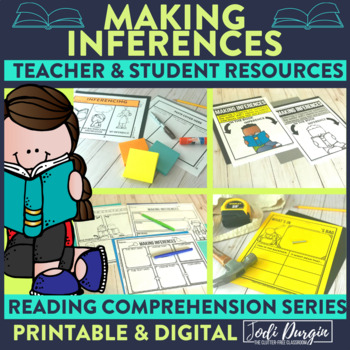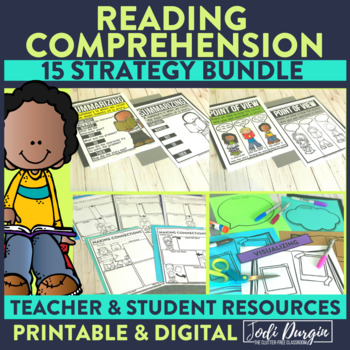Making inferences is an important reading comprehension strategy for elementary students to become proficient in. When readers make inferences, they use details from the text and their personal experiences to draw a conclusion. Readers infer when something is not directly started in the text and, instead, the reader must “read between the lines.” This strategy helps readers better understand and enjoy stories they read and listen to. Learn all about how to teach making inferences below!
What is Making Inferences?
Making inferences is a higher-level thinking strategy that readers use. When we make inferences, we are using details from the text and our personal experiences to draw a conclusion. Readers make inferences when something is not directly stated in a text. This strategy can be thought of as “reading between the lines” for being about to “read” people or a situation.
People make inferences throughout their day to day lives. For example, if a child is crying and holding their knee, you would infer that they must have fallen and hurt their knee. No one told you this information but you used the details that you saw with prior knowledge and experiences you have to make this inference.
In order to make an inference, readers first need to find clues in the text. They then pair the clues with information they already know from experience or information they’ve already read to make a logical guess. These guesses are logical because readers are able to support them with the details and experiences.
This is a challenging skill especially for younger readers because it involves high order thinking. It takes time for readers to fully develop this skill. It is important to remember that inferences are open ended, meaning there can be more than one answer.
Often, making inferences is confused with making predictions. The difference between the two is that inferences are the conclusions you can draw based on the text while predictions are the guesses you make about what will happen next.
Why Is Making Inferences an Important Comprehension Strategy?
The ability to make inferences is an important skill for students because it is one they will use throughout their life and school career. We make inferences in reading, science, social studies and even math. When students are able to successfully make inferences, they are able to think critically about a text. This helps them to have a better understanding and memory of what they read. By doing so, they are more likely to enjoy the text and reading in general.
Inferring is an important component of many other reading strategies students will use. It is used when we are identifying character traits, examining the cause and effect of actions and events, making connections, and identifying the meaning and purpose of a reading. When students make inferences while they are reading, they are gaining a much deeper meaning of the text.
Being able to infer is also important in social situations. We must be able to read how people are feeling, consider how they might react, and how we should interact with them based on a given situation.
Teaching Standards for Making Inferences
Standards for this reading comprehension topic include…
CCSS
- The Common Core State Standards do not specifically address making inferences.
TEKS
- ELA.1.6.F – The student is expected to make inferences and use evidence to support understanding with adult assistance.
- ELA.2.6.F – The student is expected to make inferences and use evidence to support understanding.
- ELA.3.6.F – The student is expected to make inferences and use evidence to support understanding.
- ELA.4.6.F – The student is expected to make inferences and use evidence to support understanding.
- ELA.5.6.F – The student is expected to make inferences and use evidence to support understanding.
3 Tips for Teaching Students to Make Inferences
Below are suggestions for when you’re teaching your students to make inferences when reading.
1. Read Aloud Picture Books
Reading aloud picture books is a great way to model and practice this reading comprehension strategy. There are tons of great read alouds out there for teaching students to make inferences when reading. Some high-quality examples include Sparky, I Want My Hat Back, My Lucky Day, Little Tree, and Stellaluna.
2. Make Anchor Charts
Anchor charts are another great way to teach students about making inferences when reading children’s books. My making inferences resource includes an interactive anchor chart that successfully engages students in their learning and provides a visual learning experience for students to learn about making inferences.
3. Use Videos
The third on the list of tips for teaching students to make inferences is playing videos. This is another great visual learning opportunity for students to learn about what can feel like a very abstract idea. Below are some examples of videos that are great for teaching students how to make inferences when reading picture books.
- https://www.youtube.com/watch?v=i_hbzv2EacM
- https://www.youtube.com/watch?v=JdaD2FZQFEY
- https://jr.brainpop.com/readingandwriting/comprehension/makeinferences/
Making Inferences Resources
These printable and digital resources for teaching elementary students about making inferences make curriculum and lesson planning quick and easy. It includes teacher, parent, and student resources, so you’ll have everything you need to deliver meaningful research-based instruction rooted in current best practices.
What is Included
1. Teacher Resources
There are teacher notes about the strategy, teaching ideas, a planning page with question prompts, and list of mentor texts, so you have all of the information you need to plan a research and standards-based reading unit based on this reading comprehension strategy.
2. Parent Resources
There is a parent letter and a reading log with suggested question prompts so parents can confidently support and reinforce the strategy you are teaching with their children at home.
3. Instructional Resources
There are printables to create a large anchor chart and reference charts. Both save you lots of time searching for anchor chart ideas and supplemental teaching tools.
4. Student Resources
There are 3 printables and 2 activities for students that provide meaningful opportunities to practice and make sense of the reading strategy in a fun and engaging way
5. Digital Resources
There are digital versions of several of the resources so students can access them in school or at home using a technology device of their choice.
Why Teachers Love this Resource
- This collection of resources is versatile in that it can be used on it’s own or can be used to supplement any reading curriculum, so you will be able to continue to use these resources if your school adopts a new reading program or you switch school districts.
- This resource is part of a larger collection of reading strategy products, so you can provide a consistent instructional approach that your students quickly learn and understand the expectations and routines for. Learn more about this collection here!
- It’s a huge time saver! Instead of hunting for background information on a reading strategy and then searching for resources to teach the strategy, this comprehensive resource includes all of the information and resources you need to teach a whole unit on this reading strategy.
- The student activities are a lot of fun for students, which helps create a productive learning environment where students are engaged and learning!
- It includes resources that provide a great way to create a home-school connection with students’ families and support parents/guardians in continuing student learning at home.
In closing, we hope you found this post about how to teach making inferences helpful! If you did, then you may also be interested in this other post about elementary reading comprehension strategies.




